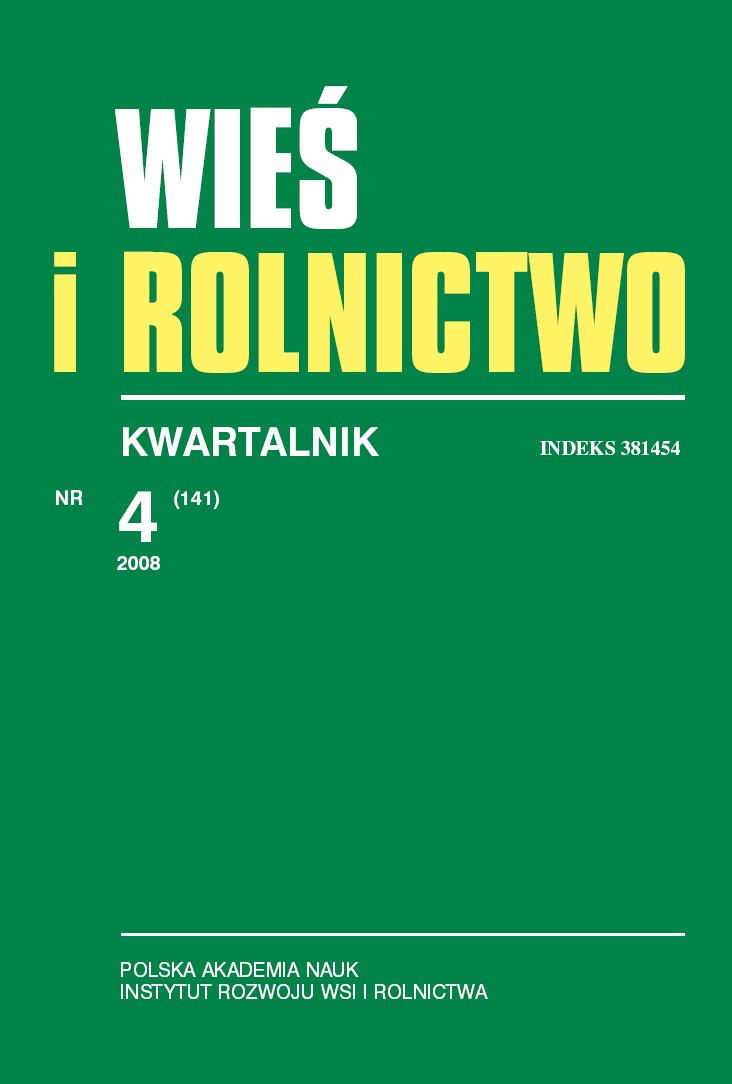Wspólna polityka rolna a polityka spójności w kontekście przeglądu budżetu UE
DOI:
https://doi.org/10.53098/wir.2008.4.141/03Słowa kluczowe:
rozwój wsi, wspólna polityka rolna UE, polityka spójności UE, przegląd budżetu UEAbstrakt
Działania z zakresu rozwoju obszarów wiejskich (ROW) realizowane są zarówno w ramach tzw. II filaru wspólnej polityki rolnej UE (WPR), jak i programów finansowanych ze środków polityki spójności. Kwestia wyboru sposobu realizowania polityki ROW nabiera pierwszorzędnego znaczenia w sytuacji obecnej debaty nad zmianami WPR. Dyskusja ta stymulowana jest zarówno czynnikami wewnętrznymi (m.in. przeglądem budżetu UE oraz tzw. health check WPR), jak i zewnętrznymi (m.in. negocjacjami WTO oraz zmianami na światowym rynku żywnościowym). Czynniki te są szczegółowo omówione w niniejszym artykule, gdzie wskazuje się, że najważniejszym katalizatorem zmian w sposobie realizacji polityki ROW może okazać się przegląd budżetu UE, który dotyczy zarówno WPR, jak i polityki spójności. W artykule wskazano na najważniejsze dylematy związane z wyborem sposobu prowadzenia działań z zakresu ROW. W tekście twierdzi się, iż biorąc pod uwagę małą mobilność czynników produkcji w Polsce, korzystne może okazać się przeniesienie ciężaru realizacji polityki ROW w większym stopniu na politykę spójności. Ponadto dowodzi się, iż zwiększenie alokacji środków UE na rozwój wsi poprzez politykę spójności kosztem ilości środków kierowanych na wieś poprzez II filar WPR może ograniczyć ryzyko zmniejszenia transferów funduszy unijnych na polskie obszary wiejskie po 2013 roku. W artykule proponuje się również mechanizm instytucjonalny realizacji polityki ROW opartej w mniejszym zakresie na II filarze WPR.Bibliografia
Burkiewicz W., Grochowska R., Hardt Ł., 2007: Przyszłość polityki rolnej a przegląd budżetu UE w latach 2008–2009. UKIE, Warszawa.
Daugbjerg C., Swinbank A., 2007: The Politics of Cap Reform: Trade Negotiations, Institutional Settings and Blame Avoidance, „Journal of Common Market Studies” 45(1): 1–22. DOI: https://doi.org/10.1111/j.1468-5965.2007.00700.x
Fouilleux E., 2004: CAP Reforms and Multilateral Trade Negotiations: Another View on Discourse Efficiency. „West European Politics” 27(2): 235–255. DOI: https://doi.org/10.1080/0140238042000214892
Gylfason T., 1995: The Macroeconomics of European Agriculture. „Princeton Studies in International Finance” 78.
Hardt Ł., 2007a: Wartość dodana wspólnej polityki rolnej dla Unii Europejskiej i Polski. W: Społeczno-ekonomiczne aspekty rozwoju polskiej wsi. Red. M. Błąd, D. Klepacka-Kołodziejska. IRWIR PAN, Warszawa: 195–209.
Hardt Ł., 2007b: Polska w UE – reforma budżetu UE oraz ocena wykorzystania środków unijnych w Polsce. W: Raport INE PAN 11: 60–64.
Putnam R., 1988: Diplomacy and Domestic Politics: The Logic of Two-Level Games. „International Organization” 42(3): 427–460. DOI: https://doi.org/10.1017/S0020818300027697
Sarkozy N., 2007: Wystąpienie w Rennes, 11.09.07.
Wichern R., 2004: Economics of the Common Agricultural Policy. „European Economy” 211, European Commission, Brussels.
Pobrania
Liczba pobrań artykułu
Strony
Jak cytować
Numer
Dział
Licencja
Prawa autorskie (c) 2008 Wieś i Rolnictwo

Utwór dostępny jest na licencji Creative Commons Uznanie autorstwa 4.0 Międzynarodowe.










